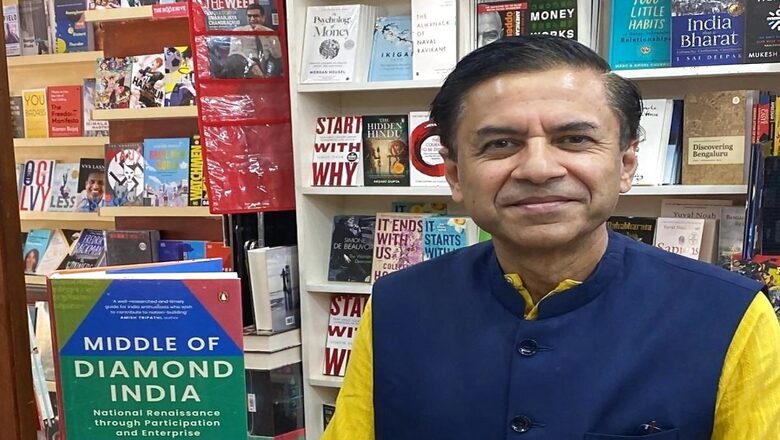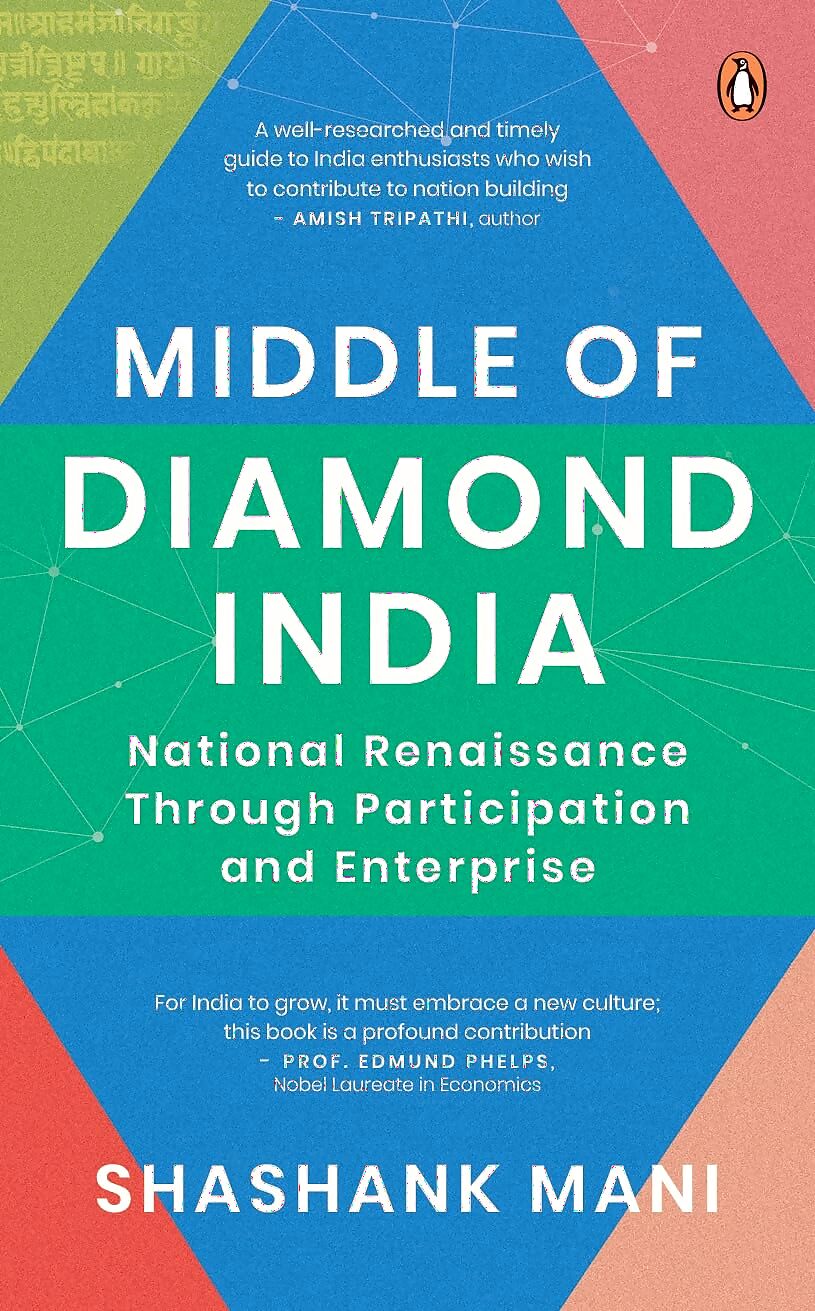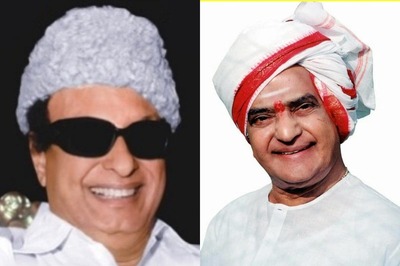
views
Renowned social entrepreneur and visionary leader, Shashank Mani, brings forth a transformative narrative with his latest work, ‘Middle of Diamond India: National Renaissance through Participation and Enterprise’. This groundbreaking book unveils the untold stories of India’s tier 2 and tier 3 districts, shedding light on the immense potential and resilience of its middle populace. Delving into India’s storied past, diverse culture, and indomitable spirit, Mani paints a vivid portrait of what he terms ‘diamond-shaped’ India.
At its core, ‘Middle of Diamond India’ advocates for a paradigm shift in how we perceive and engage with the nation’s ‘Middle’. Proposing a Banyan Revolution, the book champions the transformative power of ‘Udyamita’ in sparking a nationwide renaissance. By harnessing the entrepreneurial spirit of small-town India, Mani contends, we can not only uplift millions of lives but also chart a new course towards a more inclusive and dynamic future for the nation.
In an exclusive interview, Shashank Mani opened up about his vision for a more inclusive and prosperous India, the role of individuals and institutions in driving positive change and more…
Your commitment to public welfare is evident in your decision to quit your job and focus on initiatives like the Jagriti Yatra. How has this personal journey influenced your perspective on India’s development, especially within the context of what you refer to as the ‘middle’?
It’s essential to note that my involvement with Jagriti Yatra began while I was still deeply embedded in my professional life at PwC, demonstrating that one doesn’t have to abandon their career to contribute meaningfully to society. For about 16 years, I managed to balance a demanding job with my commitment to social welfare, showing that you can do good while still maintaining your professional and personal life. Post quitting my job in 2022, inspired by the prime minister’s vision for Amrit Kaal, I’ve dedicated myself more fully to these causes. But my message to those reading this and to society at large is that significant contributions to societal development don’t necessarily require one to become a full-time social worker. You can still have a fulfilling family life, a successful career, and contribute to society’s betterment.
The foundation of my commitment to public service was laid early on, influenced by my family’s ethos of contributing to the country. This journey, especially through interactions with inspiring individuals on the Jagriti Yatra, has reinforced my belief in the power of collective action and the impact of individual contribution towards national development. The most significant learning, I would say, is the realisation that making a difference doesn’t always require drastic changes to one’s lifestyle or career. It’s about finding the right balance and leveraging your position, wherever you are, to foster change.

The Jagriti Yatra has been described as the world’s largest entrepreneurial train journey. Could you share some insights into the logistical challenges involved in organising such a massive event?
Organising the Jagriti Yatra, a 15-day, 8000 km train journey, presents a complex logistical challenge. It involves a meticulous selection process from over 15,000 applicants to select 500 participants, ensuring a balanced gender representation, and the detailed planning of their induction and accommodation. Equipping a train with the necessary facilities, including segregated bathrooms and a pantry, and ensuring an engaging program for the journey requires precise coordination. My prior experience in offshore drilling rig management has been crucial in handling these complex logistical challenges.
The Yatra’s seamless execution for over a decade is a testament to the dedication of our team and the innovative support system we’ve created with the Engine Room Club—alumni who volunteer to ensure the current Yatra’s success. This intricate orchestration of logistics, combined with our commitment to an enriching and safe experience for all, underscores the essence of what makes the Jagriti Yatra an unparalleled entrepreneurial and educational endeavour. I’m very proud of the fact that we’ve executed it so seamlessly for so many years.
You mentioned that building India is synonymous with building districts like Deoria. Could you shed light on how empowering these districts aligns with the goal of nation-building?
When we consider the fabric of India’s development, it’s essential to recognise the integral role that districts play in shaping the nation’s trajectory. While the spotlight often falls on metropolitan cities and Tier 1 districts, the heart of India lies in its Tier 2 and Tier 3 regions, exemplified by places like Deoria. These districts, home to a significant portion of India’s population, are where the real essence of “Middle India” lies. However, they’ve been historically overlooked in terms of infrastructure, opportunities, and investment. Yet, they possess immense potential, both in terms of human capital and natural resources.
By focusing on empowering these districts through initiatives like Udyamita, we can tap into the untapped talent and resources present there. This approach not only fosters local development but also contributes to the broader goal of nation-building by ensuring inclusivity and equitable growth across all regions.
What challenges do you foresee in promoting a culture of Udyamita (entrepreneurship) in small towns and districts, and how do you propose overcoming these obstacles?
The promotion of Udyamita faces several challenges, primarily rooted in entrenched mindsets and infrastructural limitations. Firstly, there’s a prevailing belief that government jobs are superior, leading to a lack of interest in entrepreneurship. Overcoming this mindset requires a shift in societal perceptions towards valuing innovation and self-reliance. Secondly, the current ecosystem in small towns and districts is not conducive to entrepreneurial ventures, lacking necessary support structures and resources. Addressing this challenge involves creating a supportive environment that nurtures and sustains entrepreneurial endeavours. Infrastructure presents another obstacle, with many areas lacking the necessary facilities and connectivity for businesses to thrive. Overcoming this requires investment and providing access to resources such as financing and mentorship.
Despite these challenges, there’s a wealth of untapped talent and potential in these districts, waiting to be unleashed. By cultivating local role models and success stories, we can inspire others to embrace entrepreneurship and contribute to the growth of their communities. Through concerted efforts to address these obstacles and empower aspiring entrepreneurs, we can foster a culture of Udyamita that drives economic growth and prosperity in small towns and districts across India.
The notion of unlocking hidden entrepreneurial capital in the ‘Middle’ is very intriguing. Could you elaborate on the Do-Learn-Do process that goes beyond traditional classroom learning, and how it contributes to inclusive growth in the Middle through Udyamita?
When we talk about wealth creation, we often focus on labour, land, and capital. However, entrepreneurship is a vital component that is often overlooked. Entrepreneurship involves more than just labour; it requires leaders who can transform ordinary resources into extraordinary opportunities. This aspect of human entrepreneurial capital is often hidden, especially in India, where traditional classroom education doesn’t necessarily cultivate entrepreneurial skills. The Do-Learn-Do process is essential in unlocking this potential. It emphasises experiential learning, mentorship, and on-the-job training, rather than relying solely on classroom instruction.
This approach aligns with the teachings of Swami Vivekananda, who emphasised the importance of experiencing to truly learn and grow. I passed one of the toughest exams in this country, but that is not what taught me. In my experience, the most valuable lessons came from interacting with others who enter IIT and gaining practical experience, rather than just academic study. The Jagriti Yatra exemplifies this approach by bringing together 500 creative minds for a 15-day journey of exploration and learning. So, I think experiential learning will unleash entrepreneurial capital.
By treating entire districts like Deoria, or the whole of the ten districts that we have adopted, as learning environments, rather than just classrooms or offices, we can unleash the entrepreneurial spirit and drive inclusive growth in the middle.
The increase in administrative layers and population sizes per constituency is outlined as a hindrance to efficient governance. How can these challenges be addressed to ensure elected representatives and administrators can better listen to and serve citizens?
Addressing these challenges requires a multi-faceted approach. Firstly, there’s a pressing need for delimitation to increase the number of elected representatives, both at the parliamentary and state levels. The current number of MPs, set since independence, is inadequate given the significant population growth. By increasing representation, the workload on each representative can be more manageable, facilitating better governance. Secondly, there must be a shift in attitude, moving away from the notion that the government is solely responsible for addressing all societal needs. Instead, there should be a recognition that citizens, particularly those in the emerging middle class, can contribute to their own welfare through collective action and association. This shift entails empowering communities to take charge of their own development initiatives.
Thirdly, there’s a crucial role for fostering citizen participation and collaboration. Encouraging the formation of associations and promoting digital platforms for civic engagement can facilitate collective problem-solving and decision-making. Lastly, the active involvement of women in governance processes is paramount. Studies have shown that diverse participation, including that of women, enhances the effectiveness of decision-making. By implementing these measures, we can enhance governance structures and ensure a more inclusive and responsive system that meets the needs of all citizens.
How do you propose changing the narrative towards citizens as creators rather than just voters? And what impact do you believe this shift in mindset will have on governance?
The concept of “Sabka Prayas, Sabka Vikas” coined by Prime Minister Narendra Modi is pivotal in reshaping this narrative. The essence of a republic lies not only in voting but also in engaging in constructive endeavours for the nation’s advancement over the next five years. Sabka Prayas emphasises the transformation of every voter into a builder. One effective approach to achieve this is through fostering Udyamita, particularly in small towns and districts, where a significant portion of the population resides. Nobel laureate Edmund Phelps underscores that the act of creation imbues individuals with purpose, extending beyond mere economic gains. By cultivating a culture of entrepreneurship among citizens, we can ensure a more equitable distribution of wealth, fostering inclusive growth where prosperity is shared by all.
This not only bolsters economic stability but also instills meaning and purpose in people’s lives, leading to a more harmonious and secure society. Mass entrepreneurship or mass innovation thus holds the potential to drive societal transformation, transcending mere economic considerations to encompass broader social dimensions.
As India turns 100 in 2047, your book proposes a vision for a new modernity aligned with culture. Could you elaborate on the core principles of this envisioned modernity, and how it fosters a harmonious balance between cultural values and economic progress?
The modernity that we’ve been urged to embrace has predominantly been dictated by Western ideologies, largely stemming from the era of colonialism. Our indigenous culture was suppressed during the two centuries of British rule, with the imposition of a European-centric notion of modernity. This paradigm was based on Cartesian philosophy, viewing humans as mechanical entities and endorsing the conquest of nature for material prosperity. It was epitomised by the colonisation of vast territories like the United States and Australia, leading to industrialisation, nuclear families, urbanisation, and the glorification of individualism. However, this model did not resonate with the essence of the Indian heartland, where traditional values of family, community, and spirituality prevailed.
The heartland, or the “Middle,” as I refer to it, largely escaped the influence of this extractive modernity, which remained concentrated in metropolitan areas.
My proposition is that the new modernity must originate from a different source, not the metropolises or the West, as they are deeply entrenched in their existing paradigms. The current global environmental crisis, a direct consequence of extractive modernity, necessitates a fundamental shift, and this change will emerge from the heartland. The heartland embodies originality and is grounded in familial and spiritual values, recognising interconnectedness with all forms of life. Unlike the Cartesian worldview that positioned man as the conqueror of nature, our traditional perspective sees humanity as an integral part of the cosmic fabric, where humans, animals, plants, and all existence coexist harmoniously.
By embracing this interconnectedness, we can engineer a new modernity that celebrates integration, humanism, decentralisation, family, and spirituality. This transformative vision is not limited to India but extends to regions like Africa, Southeast Asia, and Latin America, which have preserved their originality despite Western influences. It promotes fraternity over autonomy and community over individualism, offering a more inclusive and sustainable path of development.
What is your vision for India’s Middle, and how do you hope your book will contribute to shaping that future?
My vision for the Middle is that it becomes the epicentre of the next phase of India’s growth over the next 25 years. It embodies our rich civilisational heritage, boasts originality, and represents the vast majority of our population. This segment is no longer impoverished and possesses the capacity to be self-reliant. I envision a scenario where every individual among the 800 million people in the Middle starts believing in themselves, embracing the concept of “atmanirbharta” or self-starters, as advocated by the prime minister. If we can harness the collective energy and aspirations of this massive demographic, India’s trajectory of progress will be fundamentally altered.
This vision of self-reliance can be fueled by Udyamita, which transcends mere entrepreneurship to encompass a mindset of proactive problem-solving in any field. Whether one is a Gram Pradhan or a business owner, as long as they champion local solutions, humanistic values, and technological innovation for the greater good, they embody the spirit of Udyamita.
This vision isn’t about neglecting the top or bottom segments of society. The affluent and globally connected top tier, as well as the upliftment of the marginalised bottom tier, are crucial. However, I advocate for a “middle-up” approach, wherein the dynamic energy of the middle class, when combined with the resources and influence of the top, can effectively uplift the bottom tier. My vision rejects the notion of trickle-down economics, instead focusing on empowering the Middle to uplift the entire nation.
I would like to touch upon the Banyan Revolution because it encapsulates the essence of my vision. We aim to ignite a movement fueled by Udyamita, not confined solely to Deoria, but also extending across the nation. Our vision involves establishing key centres, referred to as ‘char dhams’ which represent pivotal nodes for the Banyan Revolution. These centres include locations in Deoria, Kanyakumari, Ganjam (Odisha), Nagpur (Maharashtra), and the Diamond Institute in Mumbai. By establishing these four centres and an additional institute in Mumbai, we anticipate catalysing a significant national movement.
Views expressed in the above piece are personal and solely that of the author. They do not necessarily reflect News18’s views.



















Comments
0 comment